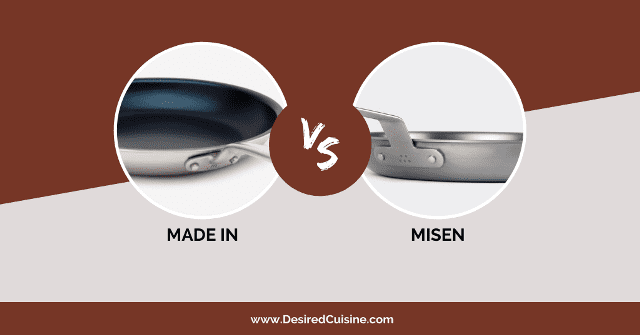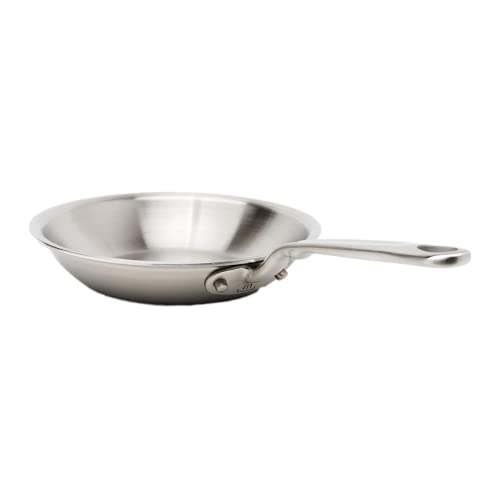It can be quite difficult to choose between Misen and Made In. Both companies are two of the new rising cookware brands that claim a ton of benefits for their consumers. But do they worth the hype? In this comparison, I will cover in detail the differences and similarities between Made In and Misen, as well as their unique features; their pros and cons; and which one is superior in terms of heat performance, collections, durability, design, and price.
Quick Summary
Feature | Misen | Made In |
|---|---|---|
Construction | 3-Ply and 5-Ply | 5-Ply |
Material | Stainless steel / Carbon steel / Nonstick / Cast iron | Carbon Steel / Copper / Stainless steel / Aluminum |
Oven-safe temperature | Up to 500 degrees | Up to 1200 degrees |
Induction compatibility | Yes (except for nonstick pans, they don't perform great on induction burners) | Yes (except for the copper cookware) |
Metal utensil-safe | Only the stainless steel cookware | No |
Dishwasher-safe | Only the stainless steel cookware | Only the stainless steel cookware |
Handle type | Stainless steel with removable silicone | Stainless steel |
Lid type | Silicone | Silicone |
Number of collections | 3 | 4 |
Lifetime warranty | Yes (except for the nonstick cookware) | Yes (except for the nonstick collections, they come with limited-time warranty) |
Price |
Introducing Misen
Misen is an American company that was founded by Omar Rada in 2015. it produces most of its products in China where its manufacturing partners are located.
This brand is known for its versatility, it creates a wide range of kitchen products such as pans, woks, pots, dutch ovens, kitchen tools, oven steels, santoku, and other types of kitchen knives.
Pros of Misen Cookware
- Variety of cookware. Misen uses different types of material such as stainless steel, enameled cast iron, carbon steel, and nonstick in its cookware constructions to create non-toxic pots and pans that can ensure high performance while excelling in specific aspects.
- Safe nonstick surface. This brand combines a 3-layer Dupont platinum coating that’s PFOA-free with its unique Plasma primer technology to produce a safe nonstick surface that can secure a smooth release.
- Great heat tolerance. The nonstick and carbon steel lines are oven-safe up to 450 degrees Fahrenheit, while the stainless steel cookware can endure up to 500 degrees.
- Inexpensive products. Misen focuses on delivering high-quality cookware at reasonable prices directly to its customers. Thus, you can expect one of the best cookware under $200.
Cons of Misen Cookware
- No warranty. Most trusted brands offer at least a limited-time warranty that covers defects but unfortunately, Misen offers none for its nonstick cookware.
- Medium quality of the nonstick coating. I’m not quite happy with the overall quality of the coating. It may start to chip after a couple of months of daily use, even with proper care. Certainly, nonstick pans are replaceable over time but I would like to have a pan that can last for at least 3 to 5 years.
- Re-seasoning. Seasoning is a must for every carbon steel pan since it creates a layer of natural nonstick coating. However, this layer can easily be stripped if you use a dishwasher, abrasive tools, or simply a dish soap which would force you to re-season the cookware all over again.
Introducing Made In
Made In is a United-stated based company that was founded by Jake Kalick and Chip Malt in 2016. It has several manufacturing partners in France and Italy where it crafts most of its cookware.
Made In prefers to craft different types of cookware that can deliver promising performance using different materials such as stainless steel, nonstick, and carbon steel to meet the demands and expectations of its consumers.
Pros of Made In Cookware
- Safe coating. This brand does not disclose any sort of information about the nature of its nonstick coating which makes me a bit concerned about the quality. Nevertheless, it is PFOA-free and safe to cook with.
- Superb heat tolerance. As I have mentioned in the Made In vs All-Clad comparison, Made In produces cookware that can easily secure great heat tolerance. For instance: the 5-ply stainless steel cookware can endure up to 800 degrees Fahrenheit, while the carbon steel pans can go up to 1200 degrees.
- Great Induction compatibility. Most of the pans and pots this company crafts including the nonstick collection will deliver great performance on induction cooktops or any heat source, except for the copper cookware.
Cons of Made In Cookware
- Limited warranty time. Made In offers a lifetime warranty for all its cookware except the nonstick line, every piece comes with just one year warranty. Undeniably, the nonstick coatings will degrade over time however, high-quality coatings are supposed to last for around 5 years without losing their qualities.
- Less nonstick layers. Trusted brands normally coat their nonstick cookware with three nonstick layers or more to secure smooth surfaces with high durability. However, in Made In’s case, It coats its pans with only two layers using its technology “Made Slick”.
- Extra maintenance work. Made In carbon steel cookware requires extra care and maintenance work to do, particularly the natural coating generated from patina and seasoning which can easily be stripped if not properly taken care of. (more detail in the cooking surface section below)
- Bad customer service. This company’s customer service is not quite good compared to popular brands such as All-Clad and Viking. Especially, when you try to use the warranty to get a refund or a replacement for your cookware that has some sort of defect.
Misen vs Made In: Similarities and Differences

Made In and Misen share some common similarities. However, they differ in almost every element, starting from construction methods to the final price. Without further ado, here are the five main differences that you need to know before choosing either brand.
Material and Construction
Made In is known for its carbon steel construction where it attempts to craft hybrid pans that exceed the features of cast iron, stainless steel, and nonstick combined. The cookware will heat up and cool down quickly even on a low heat setting while securing great heat tolerance to withstand even higher temperature degrees.
Aside from the carbon steel, Made In relies heavily on the 5-ply construction to craft its stainless steel cookware. This construction method combines layers of aluminum with a high-grade ferritic 430 and a layer of 304, 18/10 stainless steel.
The layers of aluminum are the core of the cookware that serve to enhance the durability and heat conductivity, while the high-grade ferritic 430 is used to allow the cookware to perform perfectly without losing any of its qualities on induction cooktops. Lastly, the layer of 304, 18/10 stainless steel is applied to the surface to secure high corrosion and rust resistance for safe and healthy cooking.
Misen on the other hand is recognized for its stainless steel and nonstick cookware but, recently it focuses more on adding carbon steel and cast iron pots and pans to its collections.
Similar to Made In, Misen creates its high-quality cookware using a 5-ply construction where it combines layers of aluminum with 18/10 stainless steel. As for the nonstick pans, It crafts a flat nonstick base from a 4.2mm thick, commercial-grade aluminum that can provide excellent even heat distribution.
Cooking Surface
As I have explained above, both Made In and Misen craft 304, 18/10 surfaces for their stainless steel cookware to ensure a durable yet safe interior that can easily resist rust and corrosion. But, since it is pure stainless steel, cleaning can be sometimes difficult and a bit time-consuming.
The only key difference between the two brands is that Misen creates larger brushed stainless steel surfaces than Made In.
For the nonstick category, Misen combines its unique technology “Plasma Primer” with three layers of Dupont platinum. The plasma primer as I have covered in Misen vs Hexclad is a pretreatment done before applying the nonstick coating to ensure great durability and abrasion resistance of the coating. While the 3-layer Dupont platinum offer and maintain a superior release.
Unlike Misen, Made In doesn’t disclose any sort of information about the pretreatment and the nature of their nonstick coating. However, this brand coats the surfaces with just two layers of PTFE coating that’s PFOA-free using its Made Slick technology. Overall, the coating is completely safe and 65 compliant.
That being said, Made In still falls short compared to Misen when it comes to durability and long time performance.
As for the carbon steel collections, both brands do an excellent job in producing pans that can heat up and cool down quickly while distributing evenly. The surface requires seasoning and proper daily use to develop a natural nonstick layer over time (usually takes around 2 months). However, keep in mind that this seasoned layer can easily be stripped if not properly maintained.
Here are the seven things that you must never do to preserve the seasoned layer:
- Do not cook in high heat.
- Do not cook acidic foods.
- Do not use metal utensils.
- Do not leave them in water.
- Dry your pans immediately after every cleaning.
- Do not use a dishwasher.
- Always reseason your pan after every use.
Design
Made In prefers to have a shallow design with lower sidewalls, inclined edges, and a smaller cooking surface for most of its cookware.
The shallow design reduces some of the weight obtained from the 5-ply construction making every pan a bit easier to carry for the average person. While the inclined edges help you slide and pour your cooking off the pan.
The only flaw in this design is that the small surface is not evenly polished which causes the oil sometimes to run to the end of the sides.
Similar to Made In, Misen crafts its cookware with curved edges but with a wider surface to make it easier for you to cook more food at once and toss them around. The only downside in this design is the weight.
thanks to the 5-ply construction, Misen’s stainless steel pans are quite heavier than your ordinary cookware which makes handling every piece a bit uncomfortable for every home cook, but not to an extent that you can't carry it with one hand.
Lastly, Both brands add a magnetic base to their design to ensure great compatibility for their cookware to perform perfectly on inductions cooktops as well as other heat sources without losing any of their qualities.
Handle
Unfortunately, both Made In and Misen don’t add any great stay-cool feature. They are quite simplistic when it comes to designing the handles.
Made In creates oversized handles with a flat shape design and too much curve that forces you to raise your elbow to pick up the cookware. the flat shape makes the cookware feel heavier while the length makes it a bit uncomfortable for people with shorter hands.
Misen designs long stainless steel handles covered with removable silicone with one or two open areas depending on the cookware model to help disperse the heat. However, the handles can still get warm and warmer if the cookware stays on the stove for a long time.
Price
Made In carries a heftier price tag than Misen who leans more toward providing a variety of inexpensive cookware. For a better understanding of the cost, here are some examples of Made In and Misen cookware prices:
- Misen 3-Piece Starter Cookware Set: $225
- Misen 5-Piece Essentials Cookware Set: $375
- Misen 7-Piece Complete Cookware Set: $475
- Made In The Starter 6-Piece Cookware Set: $389
- Made In The Sous Chef 11-Piece Cookware Set: $659
- Made In The Executive Chef 14-Piece Cookware Set: $899
Made In vs Misen: Cookware Comparison
Cookware Brand | Cookware Set | Cooking Surface | Core Type | Induction Compatibility | Current Price |
|---|---|---|---|---|---|
Misen Stainless Steel Pan Set | Stainless steel | Aluminum | Yes | ||
Misen nonstick Pan Set | Platinum nonstick coating modified with Plasma primer | Aluminum | No | ||
Made In 5-ply Cookware Set | Stainless steel | Aluminum | Yes | ||
Made In 5-ply Frying Pan | Stainless steel | Aluminum | Yes |
The Final Verdict
The only situation where I would choose Made In over Misen is when I’m aiming for 5-ply cookware. Despite the differences in prices, Made In offers cookware that can guarantee higher performance for a lifetime.
Aside from the stainless steel cookware, Misen provides a variety of pans that offer better nonstick quality, even polished surfaces, higher durability, and slightly better design compared to Made In and surprisingly at reasonable prices.




